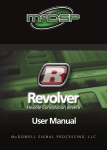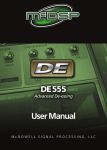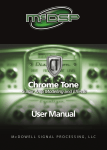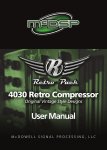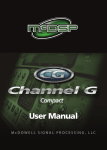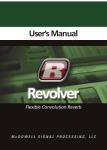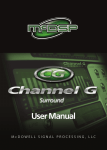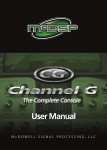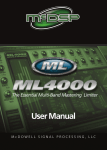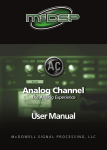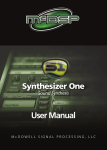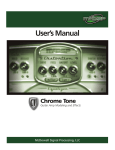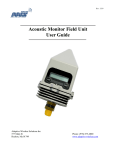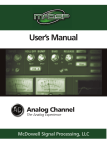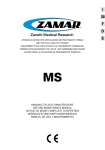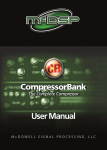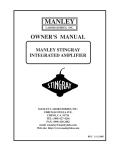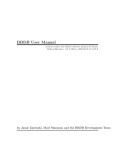Download User Manual
Transcript
FutzBox Lo-Fi Distortion Effects User Manual McDOWELL SIGNAL PROCESSING, LLC McDSP FutzBox Plug-In Manual McDSP McDowell Signal Processing, LLC 1300 Crittenden Lane #401 Mountain View, CA 94043 Support Email: [email protected] Technical Support: [email protected] World Wide Web: www.mcdsp.com Page ii McDSP FutzBox Special Thanks to: • Rob Barrett Jr., our #1 customer • Crayonmaster Studios • Stephen Hart • Matt Dow & Zamar Media • Leff Lefferts • Brett Chassen • The Hipple Farms CB Museum • LA Sammy and Jay Baumgardner at NRG Records • Tac Yamamoto • Thomas Edison • Our level 5 Beta Testers from the entire McDSP development team. Copyright Notice: Copyright 1998-2009 McDowell Signal Processing, Limited Liability Company All Rights Reserved. The McDowell Signal Processing, Limited Liability Company’s FutzBox Plug-In and corresponding User’s Manual is copyrighted and all rights are reserved. Information in this document is subject to change without notice and does not represent a commitment on the part of McDowell Signal Processing, Limited Liability Company. This document may not, in whole or part, be copied, photocopied, reproduced, translated, or reduced to any electronic medium or machine-readable form for the purpose of resale without prior consent, in writing, from McDowell Signal Processing, Limited Liability Company. Trademarks: McDowell Signal Processing, Limited Liability Company is a trademark of McDowell Signal Processing, Limited Liability Company. Other brands and their products are trademarks of their respective holders and should be noted as such. Digidesign™ and Pro Tools™ are registered trademarks of Digidesign, Inc. mcdsp.com Page iii Table of Contents McDSP FutzBox Plug-In Manual McDSP License Agreement Getting Started with the FutzBox System Requirements Installing the FutzBox Plug-In Installation on Mac OS X Installation on Windows XP and Vista Installation on VENUE D-SHOW systems Authorizing your McDSP Plug-Ins Authorizing with a pre-programmed iLok Smart Key Authorizing with an iLok License Card Authorizing with iLok.com Registering your McDSP Plug-In Using your McDSP Plug-Ins FutzBox The Quick Start Tour: The FutzBox Plug-In FutzBox Overview Controls Main SIM Lo-Fi Filters Distortion EQ/Filter Noise Generator Gate Displays Meters Response Plots General Information Control Linking Automation Page iv ii vi viii viii x x xii xiv xvi xvi xvi xx xxiii xxiii 24 25 25 27 27 27 27 28 28 28 29 29 30 30 30 30 31 31 McDSP FutzBox Presets: Using the Presets and Making Your Own A Word on Preset Compatibility Using the FutzBox Plug-In Basics Synthetic Impulse Models (SIMs) High Pass Filter (HPF) Low Pass Filter (LPF) Parametric EQ Distortion Rectification Noise Generator Gate FutzBox Closer Look Separating Noise and Audio signals SIM Tuning Audio Signal EQ Using Resonant Filters FutzBox Applications Dialog and Vocal Distortion Creating Low Fidelity Version of Music Signal Dropout Effects FutzBox Plug-In Reference Guide FutzBox DSP Delay DSP Usage HD and HD Accel DSP hardware Maximum Instantiation Counts at 48kHz Percentage of DSP used by one instantiation at 48kHz mcdsp.com 31 32 33 33 33 34 34 34 34 35 35 35 36 36 36 36 37 37 37 37 38 38 40 40 40 40 40 Page v McDSP License Agreement The software described in this manual is furnished under a license agreement and may be used only in accordance with the terms of the agreement. McDowell Signal Processing, Limited Liability Company License and Warranty: The software which accompanies this license (the “Software”) is the property of McDowell Signal Processing, Limited Liability Company or its licensers and is protected by copyright law. While McDowell Signal Processing, Limited Liability Company continues to own the Software, you will have certain rights to use the Software after your acceptance of this license. Except as may be modified by a license addendum which accompanies this license, your rights and obligations with respect to the use of this Software are as follows: You May: • authorize 1 (one) copy of the Software on 1 (one) PACE Anti-Piracy iLok USB Smart Key, for use with no more than 1 (one) computer at any given time; • make copies of the Software for archival purposes, or copy the software onto the hard disk of your computer and retrain the original for archival purposes; • after written notice to McDowell Signal Processing, Limited Liability Company, transfer the Software on a permanent basis to another person or entity, provided that you retain no copies of the Software and the transferee agrees to the terms of this agreement You may not: • copy, duplicate, or reproduce the documentation which accompanies the Software for the purpose of resale; • sublicense, rent or lease any portion of the Software to a third party without expressed written permission from McDowell Signal Processing, LLC; • reverse engineer, de-compile, disassemble, modify, translate, make any attempt to discover the source code of the Software, or create derivative works from the Software; • make any attempt to circumvent any copy protection software; • use a previous version or copy of the Software after you have received a replacement set or an upgraded version as a replacement of the prior version, unless you donate a previous version of an upgraded version to a charity of your choice, and such charity agrees in writing that it will be the sole end user of the product , and that it will abide by the terms of this agreement. Unless you so donate a previous version of an upgraded version, upon upgrading the Software, all copies of the prior version must be destroyed. Page vi McDSP Limited Warranty: McDowell Signal Processing, Limited Liability Company warrants that the media on which the Software is distributed will be free from defects. Your sole remedy in the event of a breach of this warranty will be that McDowell Signal Processing, Limited Liability Company will, at its option, replace any defective media. McDowell Signal Processing, Limited Liability Company does not warrant that the Software will meet your requirements or that the operation of the Software will be uninterrupted or that the Software will be error-free. THE ABOVE WARRANTY IS EXCLUSIVE AND IN LIEU OF ALL OTHER WARRANTIES, WHETHER EXPRESSED OR IMPLIED, INCLUDING THE IMPLIED WARRANTIES OF MERCHANTABILITY, FITNESS FOR A PARTICULAR PURPOSE AND NON INFRINGEMENT. THIS WARRANTY GIVES YOU SPECIFIC LEGAL RIGHTS. YOU MAY HAVE OTHER RIGHTS, WHICH VARY FROM STATE TO STATE. Disclaimer of Damages: REGARDLESS OF WHETHER ANY REMEDY SET FORTH HEREIN FAILS OF ITS ESSENTIAL PURPOSE, IN NO EVENT WILL McDowell Signal Processing, Limited Liability Company BE LIABLE TO YOU FOR ANY SPECIAL, CONSEQUENTIAL, INDIRECT OR SIMILAR DAMAGES, INCLUDING ANY LOST PROFITS OR LOST DATA ARISING OUT OF THE USE OR INABILITY TO USE THE SOFTWARE EVEN IF McDowell Signal Processing, Limited Liability Company HAS BEEN ADVISED OF THE POSSIBILITY OF SUCH DAMAGES. SOME STATES DO NOT ALLOW THE LIMITATION OR EXCLUSION OF LIABILITY FOR INCIDENTAL OR CONSEQUENTIAL DAMAGES SO THE ABOVE LIMITATION OR EXCLUSION MAY NOT APPLY TO YOU. IN NO CASE SHALL McDowell Signal Processing, Limited Liability Company’s LIABILITY EXCEED THE PURCHASE PRICE FOR THE SOFTWARE. The disclaimers and limitations set forth above will apply regardless of whether you accept the Software. U.S. Government Restricted Rights: RESTRICTED RIGHTS LEGEND: Use, duplication, or disclosure by the Government is subject to restrictions as set forth in subparagraph (c) (1)(ii) of the Rights in Technical Data and Computer Software clause at DFARS 252.227-7013 or subparagraphs (c)(1) and (2) of the Commercial Software Restricted Rights clause at 48 CFR 52.227-19, as applicable, McDowell Signal Processing, Limited Liability Company, Mountain View, CA 94043 ([email protected]). General: This Agreement will be governed by the laws of the State of California. This Agreement may only be modified by a license addendum which accompanies this license or by a written document which has been signed both by you and McDowell Signal Processing, Limited Liability Company. Should you have any questions concerning this Agreement, or if you desire to contact McDowell Signal Processing, Limited Liability Company for any reason, please email: [email protected]. By downloading, using, or copying this Binary Software, Licensee agrees to abide by the intellectual property laws, and all other applicable laws of the U.S., and the terms of this License. Ownership of the software shall remain solely in McDowell Signal Processing, Limited Liability Company. mcdsp.com Page vii Getting Started with the FutzBox Each McDSP plug-in is delivered inside an installer application, and uses the Interlok copy protection software to authorize each plug-in. This section describes how to install and authorize a McDSP plug-in. General system requirements are also described. System Requirements McDSP HD, Native, and LE plug-ins are compatible with Pro Tools™ HD, HD Accel TDM systems, as well as Pro Tools™ LE and Pro Tools™ M-Powered host based systems. McDSP plug-ins support Mac OS 10.4.x (Tiger), 10.5.x (Leopard), Windows XP and Vista and require Pro Tools 7.x, 8.x or greater. McDSP plug-ins require an iLok USB Smart Key. Configurations McDSP plug-ins are available in TDM, RTAS, and AudioSuite configurations. See individual products for specific available configuration sets. Applications Pro Tools™ 7.x, 8.x or higher is required for TDM, LE, and M-Powered systems. Additionally, a third party software application that supports the Digidesign TDM, RTAS, or AudioSuite plug-in standard may be supported. See http://www. digidesign.com/developers/plugin_info/ for more information. McDSP plug-ins are compatible with the entire Pro Tools™ 7 and 8 product line. Hardware McDSP plug-ins support any Digidesign or approved third party hardware supported in Pro Tools™ 7.x and 8.x. This includes HD, HD Accel, 003, and Mbox host based systems. All McDSP HD plug-ins, except Synthesizer One, also support the Digidesign VENUE D-SHOW systems. See http://www.digidesign.com/ compato/ for more specific information. The McDSP Mac versions are compatible with both Intel and PowerPC based computers. The McDSP Windows versions require an Intel Pentium 4 or greater processor.* Page viii Getting Started * McDSP Windows test machines are chosen to follow the Digidesign recommended systems guide, which currently is the Dell Precision™ Workstation 670 with 2.79 GHz Xeon processor. All products are guaranteed to run on that system. Older Intel processors (i.e. Pentium III and predecessors) and AMD processors are not officially supported, although some users have had limited success with newer AMD processors (i.e. Dual Opteron 1.79 GHZ, Athlon 64 2.20 GHz, and Athlon 64 XP 3700). None of McDSP Windows product line will work with Pro Tools™ 5.x. Also note the McDSP Windows product line does not support MIX, although RTAS versions will work if they exist and the rest of your system (i.e. Pro Tools™ version and processor) is compatible. Please visit mcdsp.com for the latest information about compatibility. mcdsp.com Page ix Installing the FutzBox Plug-In Installation on Mac OS X The FutzBox plug-in Package includes this manual, ReadMe and Release Notes, a folder of presets for the FutzBox plug-in, and the FutzBox plug-in. Two copies of the FutzBox Licensing Agreement are included - one in this pdf manual and a second as a separate text file. The FutzBox plug-in manual requires that Adobe Acrobat reader (or similar .pdf reader) is installed. Both online and boxed version will come with a FutzBox installer that will automatically install the FutzBox plug-in and its presets on your system. The authorization of the FutzBox plug-in is still required after running the installer, and those steps are detailed in the following sections. Installing the FutzBox plug-in and presets with the Installer: The online version of the package has been prepared for Internet delivery, and is transmitted as a compressed file in zip format (.zip). In Mac OS X 10.4.x or 10.5.x, simply double click the *.zip file to unpack the installer. The boxed plugin package purchased at your local dealer will be on CDROM. As with the online version, these ‘physical’ versions of the FutzBox plug-in package should be copied into a local folder on your system. • Insert the McDSP ‘HD Disk,’ ‘Native Disk,’ or ‘LE Disk’ CDROM onto an available CDROM drive. • Navigate to the FutzBox plug-in folder on the CDROM - the installer application is contained therein. • Run the FutzBox plug-in Installer application to install (copy) the FutzBox plug-in, presets, and documentation to a local folder on your system. The plug-in will be placed in the ‘Plug-Ins’ folder, and the presets will be placed in the ‘Plug-Ins Settings’ folder. • If a previous version of the FutzBox plug-in (or other HD, Native, or LE version) was already in the plug-ins folder, it will automatically be updated (or replaced) by the installer. Page x Getting Started Re-installing the FutzBox plug-in presets manually: In you wish to restore the factory default presets, it may be useful to know how to manually re-install only the presets. • Go to the ‘Plug-in Settings’ folder: • Root->Library->Application Support->Digidesign->Plug-in Settings • If Pro Tools™ has not already done so for you, create a folder called ‘FutzBox’. • Place a copy of the folder from the FutzBox plug-in package called ‘Presets’ into the ‘FutzBox’ folder. The presets are now viewable (after restarting Pro Tools™) from the settings popup menu from the FutzBox plug-in. Note it may be necessary to re-start Pro Tools™ in order for the newly added ‘Presets’ folder to be viewable from the Settings popup inside the FutzBox plug-in window toolbar. mcdsp.com Page xi Installation on Windows XP and Vista The FutzBox plug-in Package includes this manual, ReadMe and Release Notes, a folder of presets for the FutzBox plug-in, and the FutzBox plug-in. Two copies of the FutzBox Licensing Agreement are included - one in this pdf manual and a second as a separate text file. The FutzBox manual requires that Adobe Acrobat reader (or similar .pdf reader) is installed. Both online and boxed version will come with a FutzBox installer that will automatically install the FutzBox plug-in and its presets on your system. The authorization of the FutzBox plug-in is still required after running the installer, and those steps are detailed in the following sections. Installing the FutzBox plug-in and presets with the Installer: The FutzBox plug-in package purchased at your local dealer will be on CDROM and contain a Windows self extracting executable (.exe) similar to the online FutzBox plug-in package prepared for Internet delivery. Both the boxed and online versions the FutzBox plug-in executable file will automatically install the plug-in and its presets on your system. Double click the file to launch the installer which will install the FutzBox plug-in, presets, and documentation. At any time after installation, you may access the documentation from the Windows ‘Start Menu’ under the ‘McDSP’ group. Authorization of the FutzBox plug-in is still required after running the installer, and those steps are detailed in the following sections. Note that after installing new versions of the PACE iLok drivers with the FutzBox plug-in installer, you will be prompted by the FutzBox plug-in installer to reboot your system. If you are not prompted by the installer, there is no need to reboot. • Insert the McDSP ‘HD Disk,’ ‘Native Disk,’ or ‘LE Disk’ CDROM onto an available CDROM drive. • Navigate to the FutzBox plug-in folder on the CDROM - the installer application is contained therein. • Run the FutzBox plug-in Installer application to install the FutzBox plug-in, presets, and documentation to a local folder on your system. The plug-in will be placed in the ‘Plug-Ins’ folder, and the presets will be placed in the ‘PlugIns Settings’ folder. • If a previous version of the FutzBox plug-in (or other HD, Native, or LE version) was already in the plug-ins folder, it will automatically be updated (or replaced) by the installer. Page xii Getting Started Re-installing the FutzBox plug-in presets manually: In you wish to restore the factory default presets, it may be useful to know how to manually re-install only the presets. • Go to the Plug-In Settings folder: • C:\Program Files\Common Files\Digidesign\DAE\Plug-In Settings\ • If Pro Tools™ has not already done so for you, create a folder called ‘FutzBox’. • Place a copy of the folder from the FutzBox plug-in package called ‘Presets’ into the ‘FutzBox’ folder. The presets are now viewable (after restarting Pro Tools™) from the settings popup menu from the FutzBox plug-in. Note it may be necessary to re-start Pro Tools™ in order for the newly added ‘Presets’ folder to be viewable from the Settings popup inside the FutzBox plug-in window toolbar. mcdsp.com Page xiii Installation on VENUE D-SHOW systems The FutzBox plug-in Package for VENUE D-SHOW systems includes presets for the FutzBox plug-in and the FutzBox plug-in. The FutzBox Licensing Agreement is displayed when installing the product on D-SHOW. The pdf manual can be obtained by running the Mac OS X or Windows XP/Vista version of the FutzBox Pro Tools plug-in installer on any available computer. Both online and boxed versions will come with a VENUE compatible installer that will automatically install the FutzBox plug-in and its presets on your system. The authorization of the FutzBox plug-in is still required after running the installer, and those steps are detailed in the following sections. Note that all McDSP HD plug-ins, except Synthesizer One support the Digidesign VENUE D-SHOW system. Installing the FutzBox plug-in and presets on VENUE with the ‘HD Disk’: The boxed FutzBox plug-in package purchased at your local dealer will contain a CDROM titled ‘HD Disk’ that is specially formatted to work with your VENUE console. The VENUE installers are also available online as a compressed zip file download, however you will have to take additional steps to create your own VENUE installer CD-R, see additional instructions below before proceeding with these instructions. Both the boxed and online versions of the FutzBox installer are the same and will install both the plug-in and its presets on your system. Note that after installing new versions of the PACE iLok drivers with the FutzBox plug-in installer, you will need to reboot your system. You will not be prompted to reboot, and if you don’t you may see an error message saying “TPkd driver required, and a reboot. Please reboot or reinstall the software.’ If you see this message, simply reboot the console and try again. • Insert the McDSP ‘HD Disk’ CDROM onto the CD drive. Note that neither the McDSP ‘Native Disk’ nor the ‘LE Disk’ contains VENUE compatible installers. • Ensure your system is in ‘CONFIG’ mode, you cannot install plug-ins in ‘SHOW’ mode. • Navigate to the ‘OPTIONS’ page and then select the ‘PLUG-INS’ tab. • You should now see the FutzBox plug-in available on the left hand side. • Select the FutzBox plug-in and select ‘INSTALL.’ • If a previous version of the FutzBox plug-in was already installed, it will be updated by the installer. Page xiv Getting Started Important note for FilterBank HD and CompressorBank HD on VENUE D-SHOW consoles: The first time you instantiate either of these plugins, a dialog box will appear asking you to choose a user interface preference. Choose the Knobs interfaces, as some of the Slider interfaces are too large for the VENUE display. Creating a VENUE D-SHOW Installer CD-R from the online zip file: If you do not have a boxed copy of FutzBox with the included ‘HD Disk’ CDROM, you can still obtain a copy of the VENUE compatible installers from the www.mcdsp.com website. Once you have located and downloaded the latest VENUE compatible installers from the McDSP website, you will have to take several additional steps to create a VENUE compatible Installer CD-R. For your convenience, all VENUE compatible products are located in the same downloadable zip file, so you will only have to create one CD-R to install all compatible McDSP products. • Unzip the downloaded file and locate the folder named “TDM Plug-Ins” inside the unpacked folder. • Using any CD-R burning application, burn this folder and its contents to an ISO format CD-R. It is recommended that you use a brand new CD-R for this, and do not rewrite an older CD-R. • Once you have burned this folder to a CD-R, you should see it at the root level of the disk (i.e. “D:\TDM Plug-Ins”). Important: If the “TDM Plug-Ins” folder is not located at the root level of the CD-R or has been renamed, the VENUE console may not properly recognize the installer disk. • At this point, you can follow the ‘HD Disk’ installation instructions above to complete the installation. mcdsp.com Page xv Authorizing your McDSP Plug-Ins Authorizing with a pre-programmed iLok Smart Key McDSP bundles such as the Emerald Pack come with a pre-programmed iLok Smart Key. Simply insert the iLok into any available USB port on your computer. The iLok’s indicator light will illuminate when the iLok has a proper connection. The Plug-Ins included in the bundle require no further authorization steps. As with any iLok on your system it is recommended that your iLok be registered and synchronized with iLok.com Authorizing with an iLok License Card All McDSP Plug-Ins require that a valid authorization is present on your iLok USB Smart Key. McDSP Plug-ins that are purchased individually provide this authorization on a plastic License Card (about the size of a credit card), with a small punch-out iLok License Chip. After being separated from the License Card, this iLok License Chip is to be inserted into the ‘key slot’ of the iLok USB Smart Key in order to transfer the authorization from the License Card to the iLok USB Smart Key. Note that each License Card holds ONE Plug-In authorization. The following instructions detail this process Important Note: The Authorization Wizard will prompt the user to register their iLok USB Smart Key at iLok.com. iLok.com is a service offered by PACE Anti-Piracy, Inc. and this step is recommended but NOT REQUIRED by McDSP to complete the authorization of the Plug-In. If you choose to register your iLok USB Smart Key at iLok.com, care must be taken to record your ilok.com account information (i.e. write down your User ID and Password in a safe place). If your iLok.com account information is lost, the iLok cannot be registered to another account and unfortunately there is nothing McDSP can do to help you. See iLok. com for more details about the benefits of using PACE’s iLok.com service. Note: Images in this section are for illustration only, the actual product and screens will be the name of the product you are authorizing. Page xvi Authorizing Your McDSP Plug-Ins Authorizing a McDSP Plug-In from a License Card with the Authorization Wizard: The Authorization Wizard is used to install an authorization from a License Card to the iLok USB Smart Key. To use the Authorization Wizard for the Plug-In you purchase, perform the following steps: • Insert your iLok USB Smart Key into an available USB port. • On a Mac :Locate and launch the ‘Authorizer’ application found in the ‘Authorize’ folder in the Plug-In package for the McDSP Plug-In you purchased on the CD-ROM. • On Windows XP or Vista, just launch Pro Tools™ to authorize the individual McDSP Plug-In you purchased. Note: When authorizing the Plug-In on Windows XP or Vista with a new iLok USB Smart Key, you must insert the iLok USB Smart Key and complete the Windows ‘Found New Hardware Wizard’ before attempting to authorize the Plug-In. • Select the ‘Authorize’ button to be guided through the Authorization Wizard. Note: Selecting the ‘Quit’ button at any time will not authorize the Plug-In or allow it to be used for a trial period. If ‘Quit’ is selected, the Plug-In will not be available in the Pro Tools™ insert menu. • McDSP Plug-Ins require that the user personalize their copy of the Plug-In. A dialog is displayed soliciting this information. Note that the product registration card enclosed with the Plug-In MUST ALSO be filled out as well and returned to McDSP via mail (or fax to 707-2200994). This additional mail-in registration will entitle the user to future upgrades and advance information from McDSP. mcdsp.com Page xvii • Once the Plug-In is personalized, click the ‘Next’ button to continue. • Check the ‘Use License Card’ box and press the ‘Next’ button (figure 2.3). Note: Although the Authorization Wizard may appear to allow authorization by challenge/ response, that method is currently NOT SUPPORTED McDSP Plug-Ins. • Separate the small punch-out iLok License Chip (the removable metal and plastic tab) from the License Card by pushing the cutout up and out with your thumb. Do not force your finger downward. • The iLok License Chip may now be inserted into the ‘key slot’ of the iLok USB Smart Key (figure 2.6). If the iLok USB Smart Key does not appear to be present on the system, ensure the iLok USB Smart Key is connected to a valid USB port and that the green LED is lit inside the iLok USB Smart Key. To insert the License Chip into the iLok USB Smart Key, orient the iLok USB Smart Key’s USB end to the left, and the loop end to the upper right. Insert the metal chip end of the iLok License Chip (the License Chip tab should have the metal chip side facing up towards you, not down). You should be able to visually verify that the License Chip makes contact with the iLok USB Smart Key metal card reader. • The green LED in the iLok USB Smart Key will light when it is ready to receive and transmit data. • Upon inserting the iLok License Chip, a message will be displayed indicating the authorization was installed successfully. Click ‘Ok’ in the message dialog. Page xviii Authorizing Your McDSP Plug-Ins • Once the authorization is installed on the iLok USB Smart Key, a dialog is displayed prompting the user to register their iLok USB Smart Key at the www.ilok.com website. The iLok.com website was created to allow users to manage the software authorizations on their iLok USB Smart Key. THIS STEP IS NOT REQUIRED TO COMPLETE THE AUTHORIZATION OF MCDSP SOFTWARE. The registration of the iLok USB Smart Key to an iLok.com account can be bypassed by clearing the checkbox. The user may also choose to not be asked to register again. While iLok.com is a great resource for the iLok USB Smart Key, your iLok USB Smart Key may only be linked to one iLok.com account. That is, an individual iLok USB Smart Key can only be registered to one account at a time--but a single account can have multiple iLok USB Smart Keys. If the iLok.com account information is lost, the iLok USB Smart Key cannot be registered to another account. However, an iLok USB Smart Key may be transferred between accounts if all the authorizations have been transferred off the iLok USB Smart Key. Register the iLok USB Smart Key to an iLok.com account only when you are ready to retain all the needed iLok.com account information (User ID and Password). • A ‘Finished’ dialog is displayed showing what authorization method was used. • Click ‘Finish’ to exit the Authorization Wizard. mcdsp.com Page xix Authorizing with iLok.com Required for demo, upgrade, and replacement authorizations only iLok.com can be accessed from any Macintosh or PC with an Internet connection. You can do this at home, a friend’s, or at the office as long as there is an internet connection to access iLok.com--note that you don’t have to use your ProTools system computer! You simply use this computer to connect to iLok.com and transfer authorizations to your iLok Smart Key. The iLok Smart Key can then be moved to your ProTools system to complete authorization of your Plug-In. You will need: • A computer with an Internet connection. Either a Macintosh running OS 9.2 to OS 10.3 or a PC running Windows 98, ME, 2000, XP, or Vista • An iLok USB Smart Key • A valid iLok.com account. Visit www.iLok.com and set up a free account, if you have not already done so. 1) Download and install the required client software from iLok.com. 2) Download the desired McDSP Plug-In Installer from: http://www.mcdsp.com/support/updating.html 3) To receive an upgrade or replacement authorization, send email your iLok. com account information to: [email protected] To receive a demo authorization, email your iLok.com account information to: [email protected] Insert your iLok Smart Key into an available USB port and ensure that the indicator light is lit. Once your demo, upgrade, or replacement authorization is available for transfer, your iLok.com account will display the notice saying “You have licenses” on the upper left. Begin by selecting that link. Page xx Authorizing Your McDSP Plug-Ins The next page will display the pending licenses available for download. This page will also display the name of the Plug-In, its manufacturer, the type of authorization (demo, Not For Resale, or License), the date the authorization was deposited, and the date when the authorization will no longer be available for download from the server. Before any transfer of authorizations can take place, you must synchonize your iLok Smart Key with iLok. com. This may take a moment to process depending on your internet connection. Once you have synchronized your iLok, you can select the authorization(s) you wish to transfer to your iLok. If you have multiple iLoks connected to your computer, it is important to select the correct iLok you wish the authorizations to be transferred to. Then click “Download Licenses” to begin the process. Again, this may take a moment depending on your internet connection. When the transfer finishes you will be asked to confirm the completition of the transaction, thereby letting you know that the transfer was successful. mcdsp.com Page xxi If you wish to go back into your account and visually confirm the transaction for yourself, select “View iLoks” Then select the iLok you had the authorizations transferred to. That’s it! Dont forget to logout and move the iLok Smart Key to your ProTools System if you are using another computer for Internet access. Also, you may need to install a different version of the Plug-In if you are upgrading or replacing. Transferring Authorizations with iLok.com You may freely transfer any authorization within your iLok.com account between any of your registered iLok Smart Keys. If you wish to transfer an authorization out of your iLok.com account to a different user, it will require additional support from PACE Anti-Piracy, Inc and may be subject to a service fee or limited by manufacturer restrictions. Check the www.ilok.com website for updates and developments regarding iLok USB Smart Keys and the Pace Interlok Copy Protection system. Page xxii Authorizing Your McDSP Plug-Ins Registering your McDSP Plug-In To register your McDSP Plug-In, fill out and return the product registration card enclosed with the boxed Plug-In package by mail or fax 707-220-0994. Registering your product entitles you to future upgrades and advance information from McDSP. Each individual product must be registered (even if you have multiple copies), and the product must be registered to an individual, not an entity. If you represent a company it is your company’s responsibility to notify McDSP in writing if the individual who registered the Plug-In is no longer with the company. The Company must also be able to supply matching registration information to successfully transfer ownership of the Plug-In. Using your McDSP Plug-Ins Starting a McDSP Plug-In: Follow the installation, authorization, and registration instructions above, Launch Pro Tools™, and the McDSP Plug-In and its presets are ready for use. Refer to the Digidesign™ Pro Tools™ Reference Guide for details on general Plug-In operation such as automation. Exiting a McDSP Plug-In A McDSP Plug-In is exited by clicking on the desktop or other window in the DAE application running the Plug-In, closing the Plug-In window, or de-instantiating the Plug-In. Pro Tools™ sessions will save instantiated Plug-In configurations and their settings. Refer to the Digidesign™ Pro Tools™ Reference Guide for details on general Plug-In operation. Digidesign™ and Pro Tools™ are registered trademarks of Digidesign, Inc. mcdsp.com Page xxiii FutzBox The FutzBox is a distortion and noise generator for creating low-fidelity versions of audio signals. Typical post productions require altered, or ‘futzed’ versions of dialog and other tracks that mimic the sounds of radios, phones, televisions, and other devices, often in distorted conditions. Simulations of such sonic environments are now available in a single software product. These simulations, called SIMs (Synthetic Impulse Models) provide accurate modeling in an extremely optimized format, allowing FutzBox to use less dsp power than conventional convolution based products. Furthermore, SIMs can be scaled in real-time and changed on the fly. In addition to the SIM library of sounds, FutzBox also includes filtering and EQ, distortion, a noise generator, a noise generator, a hyper active gate, and a variety of low fidelity (lo-fi) effects including downsampling and bit depth reduction. Original and distorted audio can be mixed in real-time to accommodate scene changes or other automation requirements. Features: • Library of Synthetic Impulse Models (SIMs) • Configurable ‘futz’ effects including filtering, EQ, distortion, downsampling and bit depth reduction • Flexible noise generator with ducking capability • Hyper-sensitive gate for signal dropout effects • Double precision processing • Ultra low latency • Mono and stereo versions • Supports up to 96 kHz sample rates Page 24 McDSP FutzBox The Quick Start Tour: The FutzBox Plug-In Start Protools™ and Instantiate the FutzBox plug-In • Launch Protools™ and Open a Protools™ Session. • Verify the Display-> Mix Window Shows->Inserts View option is checked. • In one of the inserts of a stereo master fader, select the FutzBox plug-in. Note the FutzBox plug-in will operate on master or regular audio tracks in mono or stereo versions. • If the insert selection does not show the FutzBox plug-In, verify that the FutzBox plug-in has been installed correctly. • For more information on starting ProTools™ and working with Plug-Ins, see Digidesign’s™ ProTools™ Reference Guide FutzBox Overview The FutzBox plug-in is design to quickly create distorted, low fidelity signals from otherwise well recorded audio tracks. A typical post production FutzBox application would be changing a perfectly good dialog track into a distorted phone call, blaring radio broadcast, or megaphone announcement. Many music productions find creative and useful ways to make a project stand out using similar effects. For example, a female diva just might sound more convincing on the last chorus if she sounds as if she is leaving a message on an answering machine as she dumps her bonehead boy friend. Using the library of SIMs (Simulated Impulse Responses), an overall sound derived from a phone, television, answering machine, etc. can be selected and scaled in realtime. This technique aims to replicate sounds previously only available using impulse responses, in a highly optimized format with no internal latency. Other modules available in FutzBox include audio filters, a flexible distortion section, EQ, a noise generator, a hyper active gate, and low fidelity effects including downsampling and bit depth reduction. FutzBox also includes a wet / dry mix so ‘futzed’ and original audio signals can be combined, or used in some alternating fashion to match what occurs on screen, replacing the current practice of running a separate ‘futzed’ audio track. Furthermore the low fidelity effect itself can change over time via control automation of any FutzBox controls, including the selected SIM preset. mcdsp.com Page 25 The interface for the McDSP FutzBox is easy to understand. The signal flow travels from left to right, top to bottom with consideration of the chosen ”SIM”. Each section can be engaged or bypassed with the button to left of the section title. Sections are explained below. SIM - Synthetic Impulse Response creates realistic models of audio gear in a adjustable algorithm with no latency Lo-Fi manipulate sample rate, filtering, and bit depth Plots - frequency response of audio filters, EQ, and noise filters Main - Input, Output, and Mix of original and ‘futz’ signal Futz Tools - audio filters, distortion, signal rectification, EQ, noise generation, and gating Page 26 McDSP FutzBox Controls Main The Main section provides input and output signal level adjustment, plus the balance bewteen the input (dry) and output (wet) signals. • Input – input signal level adjustment (-24 to +24 dB) • Mix - balance of processed (wet) and original (dry) signals • Output –output signal level adjustment (-24 to +24 dB) SIM The Synthetic Impulse Model (SIM) section accesses and adjusts the entire SIM library, showing an image of the modeled device. • SIM (Synthetic Impulse Model) - collection of sonic presets in a highly optimized format. • Tune - adjusts aspects of the SIM sonic character. Lo-Fi The Lo-Fi section provides control over down sample rates, filtering, and bit depth values. • DownSample - reduces sample rate of processed audio. • Filter - reduces some aliasing artifacts creating by downsampling effect. • Bits - selects bit depth, or resolution of audio. mcdsp.com Page 27 Filters The Filter section provides a high pass and low pass filter derived from the award winning FilterBank plug-in. • Filters - high pass (HPF) and low pass (LPF) filters • Freq – filter frequency • Q – amount of resonant peak in each filter • Slope - filter slopes are selectable (-12 dB / Oct, -24 dB / Oct) Distortion The Distortion section controls the amount of distortion and the overall distortion character. • Amount – level of distortion introduced in the audio signal • Intensity - controls distortion tone. Low settings create a ‘soft’ distortion, higher settings make the distortion sound ‘bright’ • Rectify - reduces the amplitude of the negative portion of the audio wave cycle until it reaches zero at the maximum setting. The Rectify control operates independently from the Amount and Intensity controls • Mode - selects the type of distortion algorithm adjusted by the Amount and Intensity controls Note the changes caused by the Intensity control vary with each distortion mode. For some modes like ‘Sat1’ and ‘Sat2’, increasing the Intensity affects dynamic character as well as increased distortion. For modes like ‘Nuke’ and ‘Clip’ the harshness is increased by increasing the Intensity control. EQ/Filter • Freq - equalizer frequency • Q - equalizer bandwidth or filter resonance • Gain – equalizer boost or cut (+ / - 12 dB) • Mode - selects the type of EQ or Filter. Options include high pass filter (HPF), parametric EQ, and low pass filter (LPF) Page 28 McDSP FutzBox Noise Generator The Noise Generator injects filtered noise into the audio stream to create background noise and other effects. • Level – amount of noise added to input signal • HPF - high pass filter frequency • LPF - low pass filter frequency • Duck Threshold - input signal level at which noise level is reduced by Duck control amount • Range - amount of noise level reduction once input signal is above Duck Threshold level • Recov - rate at which noise ducking action changes from full noise ducking to no noise level change Gate The Gate section provides standard gate controls, with control ranges for creating other effects such as static and signal drop out. • Thresh - input level at which signal level is reduced by Range control amount • Range - amount of signal level reduction when input signal below Threshold level • Attack - rate at which gate starts to reduce signal level • Hold - amount of time gate remains open after input level initially exceeds Threshold level • Release - rate at which gate starts to no longer reduce signal level mcdsp.com Page 29 Displays Meters The FutzBox has meters showing input signal output signal levels. These meters are most useful for confirming audio levels of the original and ‘futzed’ audio are relatively the same. Note the output control affects only the ‘futzed’ audio for this reason. As the original and ‘futzed’ audio is monitored with the Mix control, the Output control can adjust the level of the ‘futzed’ version, such that the levels of both original and ‘futzed’ can be nearly identical. Response Plots Frequency responses for the audio filters and EQ are shown in the upper plot. The lower plot contains the frequency response of the noise generator filters. General Information To adjust any of the FutzBox controls the user can: • Hold the <Command> key while dragging the slider for fine control, or • Click on the text box to highlight and edit the numeric value to get precise control (if a value outside the valid range is input, the control will default to the nearest allowed value when enter is hit) and hit <Enter>, or • Click on the text box to highlight the numeric value and then use the arrow keys to increase or decrease the numeric value, or • Use the <Option> key to bring all the controls to their default values, or • Use hardware controller surfaces supported by the FitxBox plug-in including the Mackie HUI and Digidesign’s ICON™, ProControl™ and Control 24. Page 30 McDSP FutzBox Control Linking There is no control linking capability in the FutzBox plug-in at this time. Automation All FutzBox controls are completely automatable. See the Digidesign™ ProTools™ Reference Guide, Automating Plug-Ins section. Presets: Using the Presets and Making Your Own The FutzBox is mainly targeted toward “Futzing” vocal tracks for use in postproduction, however its uses are not limited to dialog! To get an idea of the full range of FutzBox’s capabilities, the included presets have been divided up by application and should provide ample inspiration for getting your own creativity flowing. The categories of presets break down as follows General - Equally applicable to either dialog or music Tunes - Mainly intended for music • Budget - Evokes the tones common to low-end devices we hear every day • Messed Up - Highlights the outer limits of Futzing available with this product • Quirky - Gives an unpredictable twist to incoming audio • Solo Instruments - Intended to give a richness to solos on guitar, keyboards, etc. • Sweet - A subtle shaping without excessive distortion or other effects • Vintage - Harkening back to the golden age of distortion and warmth Voice - Mainly intended for dialog or singing • Character - Gives the impression or character of the different SIMs without a lot of other effects • Crunchy - Creates a gritty or harsh (sometimes garbled) effect • Noisy - Transforms clean tones into something a little (or a lot) dirtier than the original Also, be sure to experiment with the Tune control when exploring SIM types. Its effect varies with the type of content and from SIM to SIM. You never know what it will do until you try! mcdsp.com Page 31 Here are some specific suggestions about a few of the presets that help to highlight various capabilities of FutzBox. • Audition SIM Only Disables all controls except for the SIM to allow easy auditioning of the SIM by itself • Tunes - Solo Instruments - 4 Guitar Automate Tune Just like it says, try automating the Tune control for a great Wah-like effect on guitar. • Tunes - Solo Instruments - One for the Suitcase Dust off that suitcase rhodes and dirty it up a little. • Tunes - Solo Instruments - Bass Lite Throw this one on a fat bass riff for a cheesy eighties breakdown. • Tunes - Messed Up - Twinkling with Mittens A mix of original audio plus an extremely aliased version, try it on piano or organ • Tunes - Messed Up - Distorted Marimba Use this on one percussive sounds to create an ugly marimba-like quality • Tunes - Vintage - I Can Hear Your Walkman Creates the annoying sound of a nearby headphone bleed • Voice - Crunchy - Lousy Robot Feed some broadband signal through this preset and abuse the Tune control. The presets can be accessed from the ProTools™ “Plug-In Librarian” and “Plug-In Settings” pop-up menus. When auditioning presets, there can be variations in audio levels due to the ‘futz’ effects. Use the Output control to adjust ‘futzed’ signal levels as needed. To make and save your own presets, see the “Plug-In Librarian Functions” section of Digidesign™‘s DigiRack Plug-Ins Guide. A Word on Preset Compatibility Presets for the FutzBox configurations are interchangeable. ProTools™ is a registered trademark of Digidesign, Inc. Page 32 McDSP FutzBox Using the FutzBox Plug-In The FutzBox plug-in can create a variety of low fidelity sounds using the Filter, Distortion, EQ, Noise, and Gate sections. The additional sonic palette added by using SIMs (Synthetic Impulse Models) is unprecedented in this type of processing for a digital audio workstation. The following sections cover basic operation of the algorithms in the FutzBox plug-in, provide a more in depth description of some of the features of the FutzBox plug-in, and outline some applications of the FutzBox plug-in. Basics The FutzBox comes with a variety of Futz effects whose basic operation is described in the following paragraphs. Synthetic Impulse Models (SIMs) The FutzBox includes a library of modeled sonic foot prints of a variety of devices commonly used in music and post production. Devices such as radios, telephones, speakers, televisions, and many others are available from an organized menu in the SIM section. Unlike impulse responses, a SIM uses significantly less CPU power, has no internal latency, and can be manipulated in real-time. Each SIM has a unqiue set of parameters that can adjusted via the Tune control. These SIMs, when combined with the other effects available in the FutzBox offer a wide pallete of sounds to mangle audio, or create the illusion of dialog coming from a low fidelity communicaiton device for a scene in a feature film. mcdsp.com Page 33 High Pass Filter (HPF) High pass filters remove signal below the selected frequency, and pass the signal above the selected frequency unaffected (hence the term high pass). High pass filters have a slope measured in the amount of signal reduction (in dB) per frequency octave. Typically these values are in multiples of 6 dB / Oct. At the exact selected frequency of the high pass filter the signal reduction is usually 3dB, however this can change based on filter design. A high pass filter is useful for removing low frequency rumble, unwanted vocal plosives, and dc offsets. For ‘futzing’ applications, the loss of low end frequency content is typical of many communication devices including phones, walkietalkies, radios, megaphones, etc. Low Pass Filter (LPF) Low pass filters remove signal above the selected frequency, and pass the signal below the selected frequency unaffected (hence the term low pass). Low pass filters have a slope measured in the amount of signal reduction (in dB) per frequency octave. Typically these values are in multiples of 6 dB / Oct. At the exact selected frequency of the low pass filter the signal reduction is usually 3dB, however this can change based on filter design. A low pass filter is useful for background noise such as tape hiss, waterfalls, general ambient background noise. Parametric EQ Parametric EQ is used to add or subtract signals at the selected frequency, at the selected amount (gain), over the selected bandwidth (Q). Distortion A signal becomes distortion when its amplitude range is no longer linear. Some range of the amplitude is limited, and that limiting process produces a distorted sound. In the digital domain, this occurs when the signal level hits the 0 dB maximum. In the analog domain this can occur at a variety of levels, and can have varied sonic characteristics. FutzBox provides several types of distortion emulating various degrees of sonic destruction. An Intensity control varies this effect further, in sublte (and not so subtle) ways depending on the type of distortion selected. Page 34 McDSP FutzBox Rectification A signal becomes rectified when the negative (or positive) portion of its waveform is reduced to zero. This can be a problem in some communication devices under less than ideal conditions. The FutzBox allows the user to control the amount of signal rectification by controlling the amount of signal reduction in the negative portion of the audio waveform. A rectification setting of 50% will completely reduce the signal level of the negative waveform cycle to zero. A rectification setting of 100% completely inverts the negative waveform cycle. Rectification settings greater than 50% can introduce additional pitch distortion into the incoming signal. Noise Generator The FutzBox comes with a basic noise generator that can add background noise to incoming audio. High pass and low pass filters are applied to the noise so its sonic footprint can vary from that of the audio signal. A noise ducking section can be used to reduce the noise level once incoming audio exceeds a selected threshold. The amount of noise reduction is controllable via a range control, and the rate at which the noise returns to its original level is adjusted via a recovery control. Gate A gate is used to remove unwanted background or low level noise by attenuating the input signal once it falls below a threshold. In this state the gate status is commonly referred to as ‘closed’ - no audio is passing through it. In some more advanced gates (like in the FutzBox), the amount of attenuation, or range, is also controllable. A range control will allow some amount of signal to pass, or none at all. When the gate is no longer attenuating, the signal passes unaffected. In this state the gate status is commonly referred to as ‘open’. Some gates (like in the FutzBox and other McDSP products) have a hold control. The hold control sets the amount of time the gate remains open even after the signal level has fallen below the selected threshold. This prevents the gate from opening/ closing repeatedly, creating an unwanted buzzing affect on the output signal. Attack and release times determine how quickly the gate stops and starts attenuating (opens and closes). Fast attack and release times are great for percussive tracks, where the signal level is changing rapidly. Slower settings are better for vocals and bass instruments. For the purposes of sonic destruction, the FutzBox gate has some other purposes including the reduction of noise output from the noise generator when no signal is coming into the FutzBox, creating static or signal dropouts, or for altering the attack and decay of the incoming audio. mcdsp.com Page 35 FutzBox Closer Look Separating Noise and Audio signals As covered in the previous section the audio signal and noise source have separate sets of filtering. This is primarily useful for separating the audio from the noise, so the two signals compete less with each other. For example, using the high pass filter, the noise can be restricted to frequencies over 10 kHz. Then the altered, or ‘futzed’ audio can be filtered and EQ’d such that little of its main content exists over the 10 kHz frequency (maybe that is not too difficult with ordinary dialog, but you get the idea). Note the SIM sonic footprint is applied to the entire ‘futzed’ signal, so the incoming audio and noise generator output are further processed in such a way that they both appear to have come from the same source. For example, the background noise in a bad radio should have roughly the same overall sonic footprint of the audio coming out of it. SIM Tuning Synthetic Impulse Models (SIMs) are efficient emulations of actual impulse response. Furthermore, they have no internal latency, and can be manipulated in realtime. The Tuning control located in the SIM control section adjusts various parameters of each SIM for various sonic results. Each SIM has its own set of tuning parameters. Using the SIM Tuning control can adjust a given SIM to better suit a specific application. Many SIMs create interesting phasing effects when the Tune control is swept across its entire range. This effect can be useful with automation - the ‘sonic experience’ is consistent during playback, and the ‘moving’ effect provides more ‘futz realism’. Audio Signal EQ Using Resonant Filters The FutzBox first stage of audio processing is the high pass and low pass filters. These filters include controllable resonance, or filter Q. The maximum boost is approximately 24dB. These peaks are very effective at emphasizing portions of the signal spectrum. Page 36 McDSP FutzBox FutzBox Applications Dialog and Vocal Distortion Varied distortion effects are possible using the FutzBox. Some general tips on creating ‘good’ distorted dialog and vocal tracks include: • Roll off the low end of the audio using the high pass audio filter • Audition Distortion Amount and Rectify control separately as well as combined, using a variety of the available Distortion Modes. • Use the EQ to add ‘presence’ to the distortion audio • Experiment with the Scale control in the SIM section when a SIM preset is ‘almost’ what you need Finally, do not forget to balance out the level of the altered audio with the original, using the Output control. This will allow the transitions between the distorted and original audio to appear smoother, an effect that is very desirable during scene / perspective changes in post production. Creating Low Fidelity Version of Music If the goal is to make the music production sound like it is being played on an old tube radio, FutzBox is very capable of such effects. Going further, if the music is supposed to be timely (ex: a 1940’s big band sound), a judicious use of the FutzBox can go a long way in making the otherwise pristine digital recording sound as ‘retro’ as possible. The use of audio / drum loops in music production is common practice, and the FutzBox is ideal for manipulting such audio sources. If that two-bar back beat breakout needs some extra crunch, FutzBox can deliver a wide variety of sounds. Signal Dropout Effects Any gate, when set too aggressively (threshold too high, attack, hold, and release times too fast), can cause incoming audio not to pass to the output. The FutzBox gate is especially suited for such applications. The ranges of the attack, hold, and release controls are such that ‘bad’ gate settings can be obtained. When combined with the other effects in FutzBox, the results can yield realistic emulations of signal dropout effects common in many communication devices. mcdsp.com Page 37 FutzBox Plug-In Reference Guide FutzBox Parameter Range Function INPUT -24 to +24 dB input signal level adjustment MIX 0 to 100% Balance of processed (wet) and original (dry) signals OUTPUT -24 to +24 dB output signal level adjustment SIM (Synthetic Impulse Model) SIM Various Collection of sonic presets in a highly optimized algorithm TUNE 50 to 200% Variation of SIM overall frequency response LO-FI RATE Downsample amount of Lo-Fi effect COLOR 0 to 100% Amount of filtering applied to Lo-Fi effect BITS Off, 23-2 Bits Bit depth of Lo-Fi effect FREQ 20Hz to 20kHz Filter frequency Q 0 to 100% Amount of resonant peak in each filter SLOPE -12 dB / Oct, -24 dB / Oct Filter slopes Amount 0 to 100% Level of distortion introduced in the audio signal Intensity 0 to 100% Controls distortion tone. Low settings create a ‘soft’ distortion, higher settings make the distortion sound ‘bright’. Rectify 0 to 100% Reduces the amplitude of the negative portion of the audio wave cycle until it reaches zero at the maximum setting. The Rectify control operates independently from the Distortion Amount and Intensity controls. MODE Various Selects different distortion algorithms, adjustable by the Amount and Intensity controls. Filters DISTORTION Page 38 McDSP FutzBox Parameter Range Function Gain + 12 to -12 dB EQ boost or cut - not active when HPF or LPF filter types selected Freq 120Hz to 12kHz EQ or filter Q 0 to 100% Equalizer shape (parametric Q) TYPE HPF, EQ, LPF Equalizer / Filter type Level -144 to 0dB Amount of noise added to input signal HPF 20Hz to 20kHz High pass filter frequency LPF 20Hz to 20kHz Low pass filter frequency Duck Threshold -40 to 0dB Input signal level at which noise level is reduced by Duck control amount Duck -40 to 0dB Amount of noise level reduction once input signal is above Duck Threshold level Recovery 2 to 200msec Rate at which noise ducking action changes from full noise ducking to no noise level change Threshold -80 to 0 dB Input level at which signal level is reduced by Range control amount Range -80 to 0 dB Amount of signal level reduction when input signal below Threshold level Attack 0.1 to 100msec Rate at which gate opens and no longer reduces signal level Hold 0.1 to 100msec Amount of time gate remains open after input level initially exceeds Threshold level Release 10 to 1000msec Rate at which gate closes and reduces signal level EQ Noise Generator GATE mcdsp.com Page 39 DSP Delay The delay incurred the FutzBox plug-in is 3 (THREE) samples on HD systems. This is the absolute minimum number of delay samples a TDM plug-in can have. The McDSP plug-ins are designed in this manner to provide the user with the closest analog mixing console experience possible (analog inserts such as EQ and compression do not cause a processing delay when inserted into a track). DSP Usage HD and HD Accel DSP hardware The TDM versions of the Futzbox plug-in configurations use a varying amount of DSP resources for each Futzbox configuration. The table below is a listing of these DSP usages. DSP usage is shown in the Pro Tools™ System Usage window. Maximum Instantiation Counts at 48kHz Configuration FutzBox Mono FutzBox Stereo # Instantiations per DSP on HD systems 3 1 # Instantiations per DSP on HD Accel systems 6 3 Percentage of DSP used by one instantiation at 48kHz Configuration FutzBox Mono FutzBox Stereo % of DSP used on HD systems 29% 58% % of DSP used on HD Accel systems 15% 29% The Futzbox supports some higher sample rates (88.2 kHz and 96 kHz). An HD Accel card is required to run the Futzbox at 88.2 kHz or 96 kHz. For 88.2 kHz and 96 kHz operation the dsp usage is roughly doubled (2x). Page 40 www.mcdsp.com Copyright 2009 by McDowell Signal Processing,LLC. All trademarks are property of their respective owners. McDSP is a trademark of McDowell Signal Processing,LLC.









































